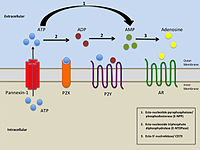
Photo from wikipedia
Cancer is one of the most influential factors causing death in the world. Adenosine which is a molecule, found in all human cells by coupling with G protein it turns… Click to show full abstract
Cancer is one of the most influential factors causing death in the world. Adenosine which is a molecule, found in all human cells by coupling with G protein it turns into an adenosine receptor. Adenosine receptor is an important target for cancer therapy. Adenosine stops the growth of malignant tumor cells such as lymphoma, melanoma and prostate carcinoma. Adenosine is activated by interacting with drugs to stop tumor cells from spreading and cure cancer disease. This research aims to predict drugs and potential drug candidates that interact with adenosine receptors. We built a machine learning model using three different classification techniques: Random Forest (RF), Decision Tree (DT) and Support Vector Machine (SVM) then we chose the best technique after comparing the results. Unlike other researches, we used the drug side effect integrated into drug fingerprint as a feature to train our model to classify drugs (interacting and non-interacting) with adenosine receptors. We ranked the interacting drugs with adenosine receptors based on drug side effects to find the most preferred drug (least side effect) among several drugs, which helps in drug design. Most existing datasets contain drugs, targets and the interactions between them, neglecting drug side effects. We formed a new dataset that has the drug side effect. The new dataset is composed of 400 drugs, 794 targets and 3990 drug side effects. Since the dataset was imbalanced we applied Synthetic Minority Oversampling Technique (SMOTE). After conducting experiments, RF achieved the best classification performance with an accuracy of 75.09%.
Journal Title: IEEE Access
Year Published: 2019
Link to full text (if available)
Share on Social Media: Sign Up to like & get
recommendations!